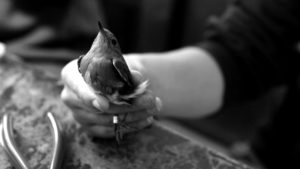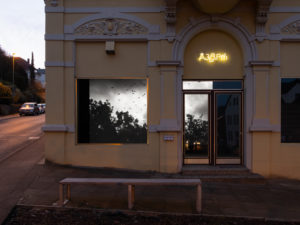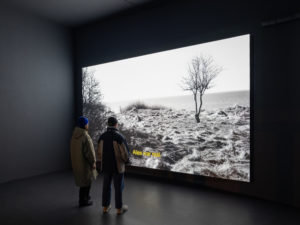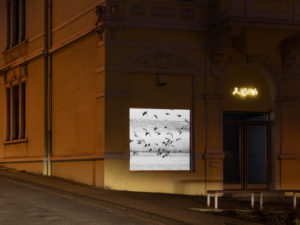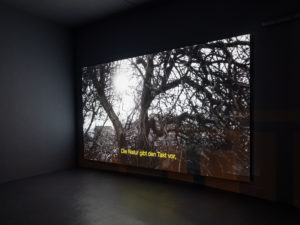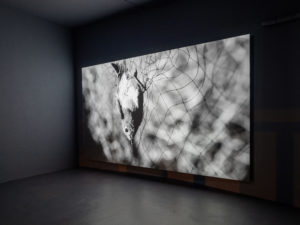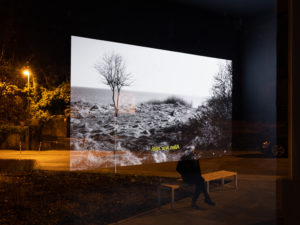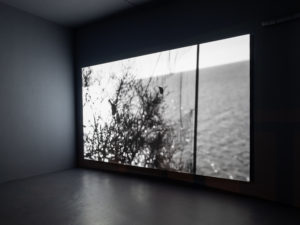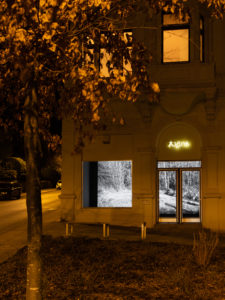13.23 Sven Johne A Sense of Warmth
More
They also mark the start of a deeper exploration of the main protagonist’s conflict-ridden ego and sense of self. The character’s introspective thoughts are juxtaposed with almost meditative black and white images of nature: flocks of birds flying across the sky in changing formations, lush landscapes of trees and bushes, a long journey on a fishing boat (christened the “Mindy”) from the mainland to an unnamed island. The images bear witness to the speaker’s new beginning on the protected island and allow us to experience, from the narrator’s perspective, the simple beauty of nature as symbolic of the better, more sustainable life that awaits.
The apparently autobiographical narrative of the 33-year-old protagonist intensifies with the story of her arrival on the island. Melinda (known as “Mindy”) has a background in psychology and previously held a mind-numbing, even dehumanizing job in process optimization. After leaving her office job for the island, she finds herself at a ringing station on the reserve, where volunteers meticulously record migratory birds for scientific purposes. Mindy describes the island’s self-sufficient and sustainable community in great detail, highlighting its many benefits: “We live here without a supermarket, without noise, without television. We live here without internet, without social media. We live a very simple life.” Her voice brims with understandable enthusiasm for their reclusive lifestyle, as the volunteers seem forever shielded from the consumerist pressures, capitalist mechanisms, and self-optimization compulsions of the Western world. They live a life without fear. Nevertheless, one cannot help but suspect that there is no such thing as a perfect life in an isolated biotope, even on an unconscious level.
The narrator meticulously describes the process of documenting migratory bird movements at the ringing station: releasing birds from specially erected nets, examining, weighing and measuring them, tagging their legs with metal rings, entering all relevant data into the computer. Two years later, this paradise is shattered by the discovery of a problem that zoologists refer to as “invaders”— an invasive species of migratory bird has taken up residence on the island, disrupting the ecosystem and threatening the entire conservation project. The same birds appearing to be landing in the nets over and over, implying that the number of new migratory birds on the island is slipping. The pragmatic solution is to allow birds caught in the nets for a third time to simply “rest” there, thus “correcting” the database. It is a difficult decision, but a necessary one to preserve the island’s ecosystem.
The ambivalence and fragility of this good life on the island, despite its closeness to nature and remoteness, is palpable throughout the film. On the one hand, there are the manipulative human interventions in the island biome—actions that serve to legitimize the conservation project at the expense of nature, interventions applied with double standards. On the other hand, at a personal level, there is the change of heart on the part of the protagonist, who subordinates her own conscience to the dogma of the good life and supposed appropriate action. The movie culminates with the protagonist falling in love. As she removes dead birds from the fishing nets, Mindy’s mind is flooded with memories of the warmth she felt when she first came to the island, how it felt when “life returned.” This feeling is paradoxical, as close to the fullness of life as it is to silent death.
And yet romantic love does not resolve the contradiction; instead, it only magnifies and obscures the human manipulation of other living creatures, the playing God. Johne captures this unsolvable dilemma as the camera mercilessly records the birds caught in the net, some of them still twitching. At first, the birds struggle with all their might to free themselves, but as they become more and more exhausted, they give up, only to raise their bodies one last time. These are provocative images; the sight of such human-inflicted cruelty may well provoke a loud cry of outrage or a feeling of powerlessness. They challenge us to take a stand, to consider whether we should maintain our objective distance or allow our emotions to be stirred.
What remains is a sense of unease about the contradictions of life that must be morally tolerated, an in-between of invented narrative and documentary, a balance between detachment and engagement. Sven Johne reflects the personal and social challenges of our time with almost unspectacular detachment, creating an unsettling space for reflecting on one’s own self-conception, thoughts, and actions. Yet the protagonist’s illogical, impotent isolation and her retreat into love soon become more disturbing than the human brutality we are made to contemplate.
In his photographs, text-image series, films, and videos, Sven Johne constructs complex narratives that ambivalently negotiate the relationship between fabrication and documentation. His work often consciously creates an uncertain state of limbo that addresses current challenges and questions of our time in connection with heroic, sometimes tragic, identifying figures and their stories, which are often anchored in a specific place or region. Since the early 2000s, the artist’s work has explored recurring motifs and themes such as East German history, the interaction of topography, history, and people, the analysis of human characters, and the interplay between fiction and documentation. Other works draw on and underscore current political events or global phenomena. The artist effectively combines archetypal elements with moving biographies, creating a strong sense of identification that places historical or regional events in a global context while making them relevant to the present.
Sven Johne (b. 1976 in Bergen, lives and works in Berlin) studied at the University of Leipzig, the HGB Leipzig and at the International Studio and Curatorial Program (ISCP) in New York. Recent solo exhibitions include those at Kunstsammlung Jena (2022); Galerie Nagel Draxler, Colonge (2022); Kunstmuseum Kloster Unserer Lieben Frauen, Magdeburg (2021); MUDAM, Luxemburg (2021, with Falk Haberkorn); Galerie Klemm’s, Berlin (2019); HMKV / Hartware Medienkunstverein (“Video of the Month”), Dortmund (2019); and the Hessisches Landesmuseum, Darmstadt (2019). His work has been included in a number of group exhibitions including the 12th Berlin Biennale, Berlin (2022) and presentations at Kunststiftung DZ Bank, Frankfurt am Main (2022); Museum Morsbroich, Leverkusen (2022); the MAST Collection / Fondazione MAST, Bologna (2022); at the Weserburg Museum für moderne Kunst, Bremen (2021); Ludwig Forum für Internationale Kunst, Aachen (2020); the Philara Collection, Düsseldorf (2020); the Karachi Biennale, Pakistan (2019); Riga International Biennial of Contemporary Art (RIBOCA), Riga, Latvia (2018); and the Triennial of Photography, Hamburger Kunsthalle, Hamburg (2018).
The apparently autobiographical narrative of the 33-year-old protagonist intensifies with the story of her arrival on the island. Melinda (known as “Mindy”) has a background in psychology and previously held a mind-numbing, even dehumanizing job in process optimization. After leaving her office job for the island, she finds herself at a ringing station on the reserve, where volunteers meticulously record migratory birds for scientific purposes. Mindy describes the island’s self-sufficient and sustainable community in great detail, highlighting its many benefits: “We live here without a supermarket, without noise, without television. We live here without internet, without social media. We live a very simple life.” Her voice brims with understandable enthusiasm for their reclusive lifestyle, as the volunteers seem forever shielded from the consumerist pressures, capitalist mechanisms, and self-optimization compulsions of the Western world. They live a life without fear. Nevertheless, one cannot help but suspect that there is no such thing as a perfect life in an isolated biotope, even on an unconscious level.
The narrator meticulously describes the process of documenting migratory bird movements at the ringing station: releasing birds from specially erected nets, examining, weighing and measuring them, tagging their legs with metal rings, entering all relevant data into the computer. Two years later, this paradise is shattered by the discovery of a problem that zoologists refer to as “invaders”— an invasive species of migratory bird has taken up residence on the island, disrupting the ecosystem and threatening the entire conservation project. The same birds appearing to be landing in the nets over and over, implying that the number of new migratory birds on the island is slipping. The pragmatic solution is to allow birds caught in the nets for a third time to simply “rest” there, thus “correcting” the database. It is a difficult decision, but a necessary one to preserve the island’s ecosystem.
The ambivalence and fragility of this good life on the island, despite its closeness to nature and remoteness, is palpable throughout the film. On the one hand, there are the manipulative human interventions in the island biome—actions that serve to legitimize the conservation project at the expense of nature, interventions applied with double standards. On the other hand, at a personal level, there is the change of heart on the part of the protagonist, who subordinates her own conscience to the dogma of the good life and supposed appropriate action. The movie culminates with the protagonist falling in love. As she removes dead birds from the fishing nets, Mindy’s mind is flooded with memories of the warmth she felt when she first came to the island, how it felt when “life returned.” This feeling is paradoxical, as close to the fullness of life as it is to silent death.
And yet romantic love does not resolve the contradiction; instead, it only magnifies and obscures the human manipulation of other living creatures, the playing God. Johne captures this unsolvable dilemma as the camera mercilessly records the birds caught in the net, some of them still twitching. At first, the birds struggle with all their might to free themselves, but as they become more and more exhausted, they give up, only to raise their bodies one last time. These are provocative images; the sight of such human-inflicted cruelty may well provoke a loud cry of outrage or a feeling of powerlessness. They challenge us to take a stand, to consider whether we should maintain our objective distance or allow our emotions to be stirred.
What remains is a sense of unease about the contradictions of life that must be morally tolerated, an in-between of invented narrative and documentary, a balance between detachment and engagement. Sven Johne reflects the personal and social challenges of our time with almost unspectacular detachment, creating an unsettling space for reflecting on one’s own self-conception, thoughts, and actions. Yet the protagonist’s illogical, impotent isolation and her retreat into love soon become more disturbing than the human brutality we are made to contemplate.
In his photographs, text-image series, films, and videos, Sven Johne constructs complex narratives that ambivalently negotiate the relationship between fabrication and documentation. His work often consciously creates an uncertain state of limbo that addresses current challenges and questions of our time in connection with heroic, sometimes tragic, identifying figures and their stories, which are often anchored in a specific place or region. Since the early 2000s, the artist’s work has explored recurring motifs and themes such as East German history, the interaction of topography, history, and people, the analysis of human characters, and the interplay between fiction and documentation. Other works draw on and underscore current political events or global phenomena. The artist effectively combines archetypal elements with moving biographies, creating a strong sense of identification that places historical or regional events in a global context while making them relevant to the present.
Sven Johne (b. 1976 in Bergen, lives and works in Berlin) studied at the University of Leipzig, the HGB Leipzig and at the International Studio and Curatorial Program (ISCP) in New York. Recent solo exhibitions include those at Kunstsammlung Jena (2022); Galerie Nagel Draxler, Colonge (2022); Kunstmuseum Kloster Unserer Lieben Frauen, Magdeburg (2021); MUDAM, Luxemburg (2021, with Falk Haberkorn); Galerie Klemm’s, Berlin (2019); HMKV / Hartware Medienkunstverein (“Video of the Month”), Dortmund (2019); and the Hessisches Landesmuseum, Darmstadt (2019). His work has been included in a number of group exhibitions including the 12th Berlin Biennale, Berlin (2022) and presentations at Kunststiftung DZ Bank, Frankfurt am Main (2022); Museum Morsbroich, Leverkusen (2022); the MAST Collection / Fondazione MAST, Bologna (2022); at the Weserburg Museum für moderne Kunst, Bremen (2021); Ludwig Forum für Internationale Kunst, Aachen (2020); the Philara Collection, Düsseldorf (2020); the Karachi Biennale, Pakistan (2019); Riga International Biennial of Contemporary Art (RIBOCA), Riga, Latvia (2018); and the Triennial of Photography, Hamburger Kunsthalle, Hamburg (2018).
Text Cynthia Krell
Translation Amy Patton
A Sense of Warmth, 2015
HD video, b/w, sound
15:35 min.
Courtesy of the artist and Nagel Draxler Galerie, Berlin / Köln / München and Galerie Klemm’s, Berlin
Written and directed by Sven Johne
Narrator Laura Wilkinson
Camera Steve Kfoury
Edit Sven Voß, Sven Johne
Translation Dawn Michelle d’Atri
Close
Translation Amy Patton
A Sense of Warmth, 2015
HD video, b/w, sound
15:35 min.
Courtesy of the artist and Nagel Draxler Galerie, Berlin / Köln / München and Galerie Klemm’s, Berlin
Written and directed by Sven Johne
Narrator Laura Wilkinson
Camera Steve Kfoury
Edit Sven Voß, Sven Johne
Translation Dawn Michelle d’Atri
